
In the ever-evolving landscape of electronics, the pursuit of more efficient and flexible circuitry has resulted in the emergence of innovative technologies. Among these, membrane printing has gained importance, playing a vital role in the advancement of electronic components. This exploration delves into the varied contributions of membrane printing in circuitry, from precision applications to the potential of transforming the very essence of electronic design.
At the core of membrane printing's impact on circuitry is its unparalleled capability to accurately deposit conductive inks onto surfaces. Traditional methods often comprise complex and expensive processes such as photolithography, but membrane printing simplifies the deposition of conductive materials with exceptional precision. This accuracy allows for the creation of detailed electronic patterns, facilitating the design and production of circuits with unprecedented levels of intricacy and detail.
Membrane printing adds a new dimension to electronic design by facilitating the creation of flexible and stretchable circuits. Traditional rigid circuit boards confine the potential applications of electronic devices, but membrane-printed circuits can conform to curved surfaces and even stretch with the underlying materials. This flexibility broadens the scope of electronic form factors, laying the groundwork for innovations in wearable technology, flexible displays, and other applications where traditional rigid circuits fall short.
In contrast to conventional circuitry manufacturing, which often relies on rigid substrates like silicon, membrane printing offers the flexibility to incorporate electronic components with a wide array of novel substrates. This adaptability extends to various materials, including polymers, textiles, and even unconventional surfaces. As a result, membrane-printed circuits can be seamlessly embedded into unconventional objects, opening up opportunities for smart textiles, flexible sensors, and electronic components in three-dimensional structures.
Membrane printing's versatility in circuit fabrication enhances rapid prototyping and iterative design processes. Engineers and designers can swiftly produce prototypes and experiment with different circuit layouts without the need for intricate and time-consuming manufacturing setups. This accelerated innovation cycle not only reduces development timelines but also encourages experimentation and creativity in electronic design.
Membrane printing's cost-effective production methods contribute to the democratisation of electronic manufacturing. By simplifying the fabrication process and reducing the need for expensive equipment, membrane printing lowers entry barriers for electronic design and production. This accessibility fosters a more inclusive environment, allowing smaller businesses and innovators to participate in the landscape of electronic manufacturing.
In conclusion, membrane printing stands as a revolutionary force in electronic design, with its precision deposition of conductive inks, flexibility, integration with novel substrates, rapid prototyping capabilities, and cost-effective production methods. The role of membrane printing in the advancement of electronics surpasses incremental improvements and ushers in a new era of possibilities in circuitry. As the technology continues to evolve, membrane printing is set to revolutionise electronic components, pushing the limits of what is possible in terms of form, function, and accessibility. The synergy between membrane printing and electronic design marks a significant chapter in the ongoing story of technological advancement, promising innovations that will shape the future of electronic devices and systems.